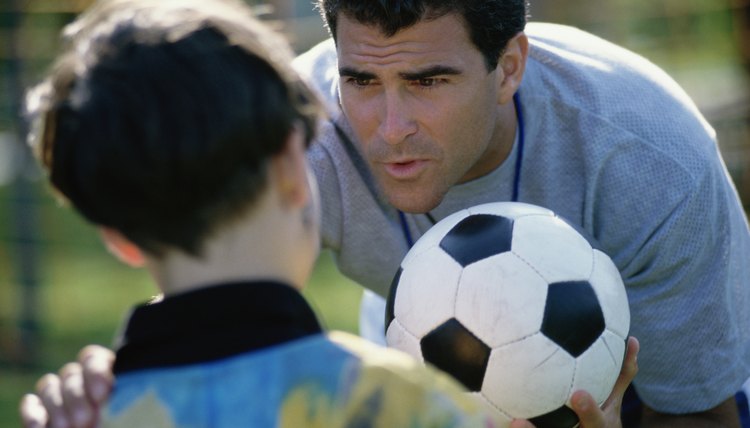How to Coach Soccer for 7-Year-Olds & Under

Seven-year-olds play on small teams of three to six players without a goalkeeper, with four players the recommended number. Playing fields measuring no more than 30 by 35 yards give them a compact space that allows more touches on the ball. Sam Snow, director of coaching education for US Youth Soccer, describes 6- and 7-year-olds as still little ones but with better balance and agility than 4- and 5-year-olds. They are beginning to experience success with their techniques and even share the ball with teammates. They simply enjoy playing soccer, so your coaching entails providing guidance to enhance their enjoyment and then getting out of the way so they can play.
Practice ball skills and fair play rather than tactics, which are beyond the ability of many in the 7-year-old age bracket, recommends US Youth Soccer's document, "The Novice Coach U6-U8: An Introduction to Coaching Youth Soccer." Repeat drills of basic skills, ball possession, balance and coordination until players grasp the concepts.
Divide players into teams of four, marked by different colored pinnies or practice vests, so they can scrimmage on fields marked by cones of 30 by 35 yards. Allow copious time for free play with allowing the 7-year-olds to learn by trial and error, discovery and experimentation, "The Novice Coach" recommends.
Direct your 7-year-olds during games to stagger themselves on the field, recommends Lindsey Blom in "Survival Guide for Coaching Youth Soccer." Ask one player to position herself slightly in front of and another slightly behind the person with the ball. For older players, this is the triangle position so critical to quick passing and avoiding defensive tackles. Though 7-year-olds move chaotically until your coaching takes hold, they eventually grasp that the triangle allows them to pass the ball effectively.
Teach players to give each other brief, clear instructions on the field during play. Phrases like "play my feet" or "send it into space" help the passer know what the receiver wants, Blom indicates. "Man on" warns a teammate that a defender is closing, while "time" indicates he can patiently look up and make an unrushed decision on what to do next.
Assign your four players on the field to a diamond formation when possible during games, so that a player acts as the main defender, another acts as the main attacker and two share the midfield. A diamond essentially creates two back-to-back triangles, Blom notes.
Tips
Attend the U-8 coaching module sponsored by your state youth soccer association. This allows parent coaches to watch a 7-year-olds' training session and to receive copies of the lesson plan from the module coach. After watching, you can run the activities with your own group of players. US Youth Soccer recommends that during games, you watch your players and cheer and refrain from giving too much direction to them. If you play a team that is short of 7-year-olds, Snow encourages you to loan a player or two so that the game can proceed.
Warnings
Do not interfere in arguments between players. This is part of the learning process, as team games call for social skills that are in the process of developing at this age level, US Youth Soccer advises.
References
- Survival Guide for Coaching Youth Soccer; Lindsey C. Blom
Tips
- Attend the U-8 coaching module sponsored by your state youth soccer association. This allows parent coaches to watch a 7-year-olds' training session and to receive copies of the lesson plan from the module coach. After watching, you can run the activities with your own group of players. US Youth Soccer recommends that during games, you watch your players and cheer and refrain from giving too much direction to them.
- If you play a team that is short of 7-year-olds, Snow encourages you to loan a player or two so that the game can proceed.
Writer Bio
Elizabeth Gray has been writing since the age of five, but professionally since the age of 21. Her current writing gigs include article writing for Studio Anya, and playwriting for the Manhattan Repertory Theatre.
